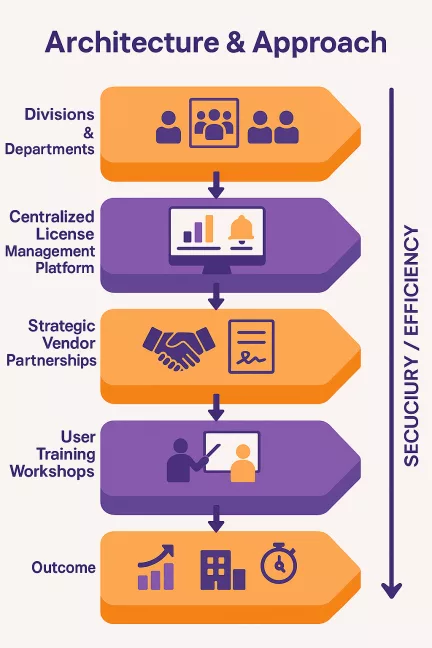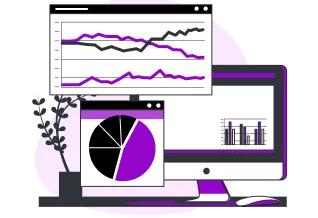Solution Overview
To bring clarity and cost savings, we led a comprehensive Licensing Optimization & Vendor Consolidation Program.
Key Features Implemented:
- Full License Usage Audit:Inventory across all business units to identify unused, underused, or duplicated licenses.
- Vendor Consolidation:Reduced the vendor list from 20+ to a handful of strategic partners by renegotiating contracts and eliminating overlaps.
- Standardized Platforms:Moved to enterprise-wide agreements for core tools (productivity suites, collaboration platforms, ITSM, cybersecurity).
- Contract Renegotiation:Leveraged consolidated buying power to secure better pricing and SLAs.
- Training & Change Management:Workshops to ensure staff adopted consolidated tools effectively and abandoned redundant ones.
- Centralized Vendor Management Dashboard:Real-time tracking of contracts, renewals, usage, and performance metrics.

Detailed Workflow
| Steps | Before Optimization | After Optimization |
|---|---|---|
| Licensing | Redundant software subscriptions across divisions | Centralized license inventory & removal of unused seats |
| Vendors | 20+ fragmented IT vendors | 40% fewer vendors; standardized SLAs & platforms |
| Contracts | Multiple renewal dates, inconsistent pricing | Consolidated contracts & renegotiated pricing |
| Training | Low adoption of tools | Structured adoption & support workshops |
| IT Support | Confusing escalation paths | Streamlined vendor contacts; 25% faster response time |
Impact and Measured Benefits
- Saved $450K Annually in Software Costs– Direct bottom-line improvement from eliminated licenses and better pricing.
- Reduced Vendor Count by 40%– Simplified support, contract management, and compliance reporting.
- Improved IT Support Response Times by 25%– Fewer escalation points and clearer vendor responsibilities.
- Enhanced Visibility & Governance– Central dashboard to monitor spend, usage, and renewal cycles.
- Future Scalability– Easier to introduce new technologies under standardized vendor agreements.

Key Takeaways for Enterprises
- Inventory First:A full audit exposes hidden waste and opportunities for consolidation.
- Vendor Strategy Saves Money:Consolidating vendors gives leverage to negotiate better pricing and SLAs.
- Change Management Is Critical:Training ensures staff embrace the new toolset and do not revert to old habits.
- Centralized Oversight:Dashboards create ongoing visibility to prevent license sprawl from reoccurring.
Solution Overview
To bring clarity and cost savings, we led a comprehensive Licensing Optimization & Vendor Consolidation Program.
Key Features Implemented:
- Full License Usage Audit:Inventory across all business units to identify unused, underused, or duplicated licenses.
- Vendor Consolidation:Reduced the vendor list from 20+ to a handful of strategic partners by renegotiating contracts and eliminating overlaps.
- Standardized Platforms:Moved to enterprise-wide agreements for core tools (productivity suites, collaboration platforms, ITSM, cybersecurity).
- Contract Renegotiation:Leveraged consolidated buying power to secure better pricing and SLAs.
- Training & Change Management:Workshops to ensure staff adopted consolidated tools effectively and abandoned redundant ones.
- Centralized Vendor Management Dashboard:Real-time tracking of contracts, renewals, usage, and performance metrics.

Detailed Workflow
| Steps | Before Optimization | After Optimization |
|---|---|---|
| Steps | Before Optimization | After Optimization |
| Licensing | Redundant software subscriptions across divisions | Centralized license inventory & removal of unused seats |
| Vendors | 20+ fragmented IT vendors | 40% fewer vendors; standardized SLAs & platforms |
| Contracts | Multiple renewal dates, inconsistent pricing | Consolidated contracts & renegotiated pricing |
| Training | Low adoption of tools | Structured adoption & support workshops |
| IT Support | Confusing escalation paths | Streamlined vendor contacts; 25% faster response time |
Impact and Measured Benefits
- Saved $450K Annually in Software Costs– Direct bottom-line improvement from eliminated licenses and better pricing.
- Reduced Vendor Count by 40%– Simplified support, contract management, and compliance reporting.
- Improved IT Support Response Times by 25%– Fewer escalation points and clearer vendor responsibilities.
- Enhanced Visibility & Governance– Central dashboard to monitor spend, usage, and renewal cycles.
- Future Scalability– Easier to introduce new technologies under standardized vendor agreements.

Key Takeaways for Enterprises
- Inventory First:A full audit exposes hidden waste and opportunities for consolidation.
- Vendor Strategy Saves Money:Consolidating vendors gives leverage to negotiate better pricing and SLAs.
- Change Management Is Critical:Training ensures staff embrace the new toolset and do not revert to old habits.
- Centralized Oversight:Dashboards create ongoing visibility to prevent license sprawl from reoccurring.





